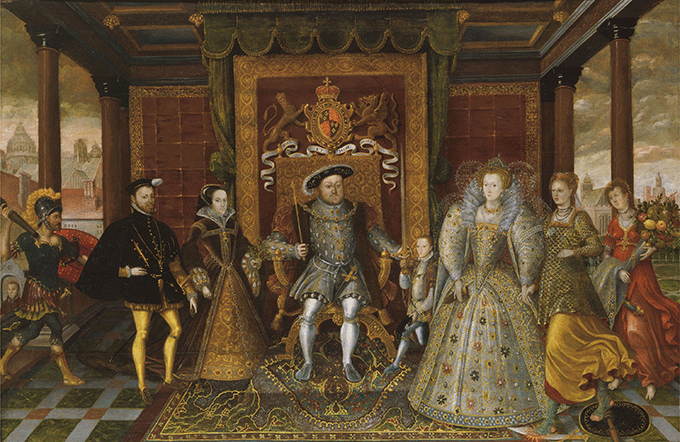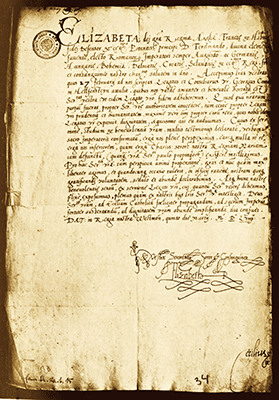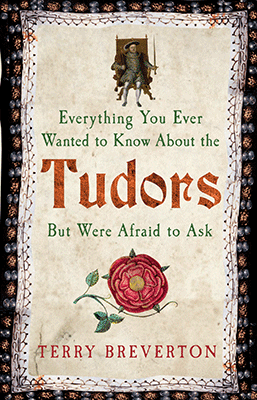Think you’re well versed in the realities of Wolf Hall? Author Terry Breverton shares his insight into the most fascinating royal household in British history, the Tudors.

1. Thomas More was no saint
Not to Protestants anyway – he had 40 of them imprisoned and another six burnt alive. In 1529, More became Lord Chancellor on the fall of Wolsey, and he ruthlessly persecuted Protestants while strongly opposing the proposed relaxation of the heresy laws. In 1530 a Protestant named Thomas Hitton was burned at Maidstone. With characteristic Christian tolerance, More called him ‘the Devil’s stinking martyr’. According to Samuel Johnson, More ‘was the person of the greatest virtue these islands ever produced’. He was made a saint in 1936. Recently, two Catholic bishops have complained that the TV series Wolf Hall makes him appear ‘more of a sinner than a saint’, calling him a man of the greatest integrity.
2. Tudor was not the family name
It should have been the Merediths, Maredudds, Meredudds or even Bowens. King Henry VII’s grandfather, one of the founders of the Tudor dynasty, was known as Owain ap Maredudd (Owen Meredith) from his birth around 1400, through his time in France around 1421 and when granted letters of English denizenship as ‘Oweyn fitz Meredyth’ in 1432. He was known as Owen Meredith and similar names during his imprisonment in Newgate in 1438. Known as ‘Owen ap Maredudd’ he was in the court party that went to France in 1444 to bring back the young Margaret of Anjou, the king’s new queen. The Owen or ‘Owyn’ Meredith in the royal household between at least 1444 and 1453 is almost definitely Owen Tudor. Then again, it easily could have been the Owen or Bowen (ab Owen) dynasty. Neither of Owen’s sons Edmund or Jasper are noted in the English records as the ‘son of Owen’. Like him, they are called ‘ap Meredith ap Tydier’ in 1437, whereas they should have been called ‘ab Owen ap Meredith’.
3. King Henry VIII was neither bearded nor fat
Henry was clean-shaven during the early years of his reign and first grew a beard only in 1519 as part of a friendly pact with François I of France. He soon shaved it off to please his wife, Catherine of Aragon, but from around 1525 sported a beard, so for only 21 years of his life did he have a beard, which then became fashionable among his courtiers. He only began to put on weight after being unable to play sports or hunt, from his time with Anne Boleyn. He was then 45 years old.
He lived to be 55, and it was only in his last five years that he grew into obesity. Aged 23 in 1514, his chest circumference was 42 inches, and his waist 35 inches. After 1528, he gradually became larger and by 1536, his chest measurement was 45 inches, and waist 37 inches. However, by 1541, aged 50, he had become enormous – with a chest measurement of 57 inches and a waist measurement of 54 inches. Henry, however, was merely playing at obesity compared to Queen Victoria. She went from 20 inches aged 18 (size zero) to something around 56 inches (size 38) with her ‘spilt drawers’ recently auctioned. Having nine children could not have helped. She was just under 60 inches tall, so would have been ball-shaped.
4. Henry VIII, Edward VI and Mary I were not British monarchs
They were English, not British. The English were never called British or Britons until Elizabeth I’s reign, at the suggestion of Dr John Dee, basing claims for an empire overseas upon the legends of British kings over foreign realms. The case of the Celts taking Rome under Brennius (the Welsh for king is brenhin, and brennius is its Latin equivalent) seems to have been conflated with the legendary Arthur’s expeditions across Europe. Equally Dee used the legend of Prince Madog ap Owain Gwynedd discovering America in 1170 to justify Northern American expansion into former ‘British’ territories. Until late Elizabethan times, Britons and British referred only to the Welsh.
5. Henry VIII did not have six wives
As his marriages to Catherine of Aragon, Anne of Cleves and Anne Boleyn were annulled, i.e. illegal (Anne Boleyn’s marriage being annulled just before her execution), King Henry VIII technically only had three wives. The annulment of the marriage to Catherine of Aragon was on the grounds that she had already been married to his brother, although this annulment was never recognised by the Catholic Church and nor were his succeeding marriages, so according to the Catholic Church, Henry only ever had one wife. Anne Boleyn was subject to an annulment on the grounds that she had allegedly seduced him with witchcraft and was incestuous and unfaithful. The marriage to Anne of Cleves was annulled as the marriage was unconsummated (and therefore was not legal) and because she had previously been engaged to someone else. The marriage to Catherine Howard was never annulled. She had committed adultery with Thomas Culpeper, so on 22 November 1541, it was proclaimed at Hampton Court that she had ‘forfeited the honour and title of Queen’, and was from then on to be known only as the Lady Catherine Howard. Under this title she was executed for high treason three months later.
6. Anne Boleyn was not guilty of adultery
Three days before her execution on charges of adultery, Anne’s marriage to Henry was annulled and declared invalid. Thus she could never have committed adultery. She was thus executed for the crime, when she never in law had been married to the king. No-one thought to bring this legal injustice to Henry’s attention…

7. Elizabeth was not universally loved by her subjects
Among the known assassination attempts against Queen Elizabeth I there was the Northern Rebellion (1569); the Ridolfi Plot and assassination attempts (1571); Anthony Tyrrell’s Plot (1581); the Throgmorton Plot (1583); the Somerville Plot (1583); Dr Parry’s Plot (1548); the Babington Plot (1586); Dr Rodrigo Lopez’ poisoning attempt (1594) and the Essex Plot (1601).
8. ‘Blood Mary’ was not a deserved reputation
This is Elizabethan propaganda. It should have been ascribed to the far, far more murderous reign of ‘Bloody Henry.’ The exact figure may never be known, but according to Raphael Holinshed, the English Chronicler who died in 1580, the number of executions in Henry VIII’s 38-year reign amounted to 72,000. This is probably an exaggeration, but many thousands of the poor were executed during the reign of Henry VIII, most for what are now regarded as minor crimes such as stealing.
9. Elizabeth was not the last of the Tudor dynasty
It is always reported that there was no Tudor successor to Elizabeth I. However, Lady Catherine Grey (The Lady Herbert of Cardiff, 1540–1568) married Edward Seymour, 1st Earl of Hertford, for which she was confined by Elizabeth I to the Tower until her death. Seymour was fined the enormous sum of £15,000 for seducing a virgin of the royal blood, and Elizabeth had their sons officially declared illegitimate, although she had no authority to do so. Catherine Grey died without the legitimacy of her two sons, born in the Tower, ever being proven, but this was later established after the death of Elizabeth I.
Catherine Grey being dead, her sons should have succeeded upon Elizabeth’s death. Edward Seymour was the elder of her sons born in the Tower of London, where his mother had been imprisoned for secretly marrying his father, against the wishes of the queen. His mother was already pregnant when she entered the Tower, and was given poor living conditions, apparently in the hope that she would either miscarry or die. For many years, her children Edward and Thomas were regarded as illegitimate because no proof could be produced of her legal marriage. Regardless of legal problems, by 1603 Edward Seymour, Viscount Beauchamp was the senior qualified heir of Henry VIII’s will, stipulating that the elder line of Stuart, through Margaret Tudor, should be passed in favour of the younger line, through Mary Tudor, his favourite, younger, sister. Edward Seymour’s only possible rival under the will was Anne Stanley, Countess of Castlehaven (1580-1647), who would have been heir if Edward and his brother Thomas were considered illegitimate.
Lady Mary Grey (1545–1578) was, like her sisters Lady Jane and then Catherine, next in line to the succession under Henry VIII’s will as Elizabeth I was childless, but Mary was persecuted by the queen. Upon Mary Grey’s death, Margaret Stanley, Countess of Derby, should have been the heiress to Elizabeth. Her son Ferdinando was probably poisoned in 1594, aged 35, and would have been heir to Elizabeth, giving us a King Ferdinando I.

10. The Tudors were very tall
King Henry VII was 5 feet 9 inches, but his son Henry VIII was 6 feet 2 inches, probably following his mother’s father King Edward IV, who was 6 feet 4 inches. Catherine Parr was thought to be around 5 feet 10 inches. The hundred or so skeletons of crewmen recovered from the Mary Rose indicate an average height of 5 feet 7 inches to 5 feet 8 inches – taller than the average male in the early 20th century.
Terry Breverton is the author of the book Everything You Ever Wanted to Know About the Tudors But Were Afraid to Ask, published by Amberley.
Related articlesThe Tudor kings and queens of England |
Click here to subscribe! |
Download BRITAIN Magazine to your mobile today

 No mobile device? Purchase directly on Zinio for your desktop!
No mobile device? Purchase directly on Zinio for your desktop!





 © 2024
© 2024